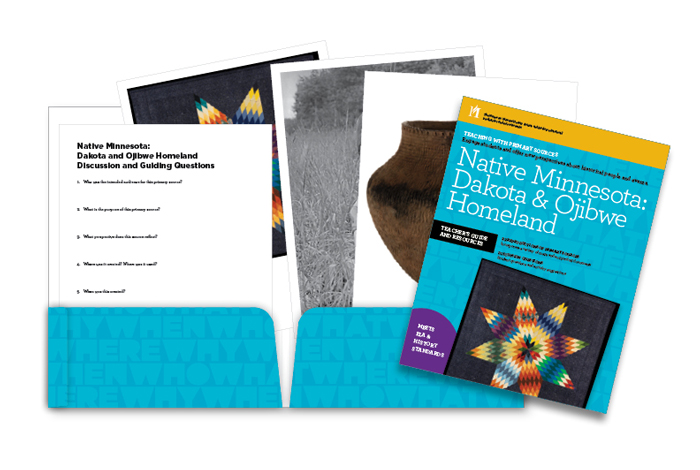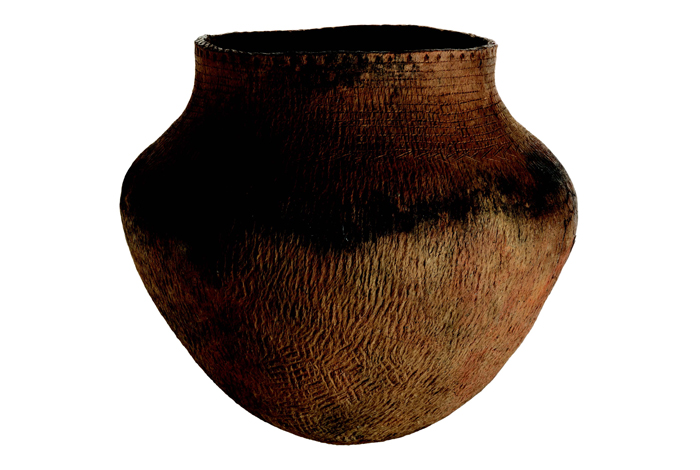Primary Source Packet: Native Minnesota: Dakota & Ojibwe Homeland

Use primary sources in your classroom to learn about Dakota and Ojibwe homeland.
The Native Minnesota: Dakota and Ojibwe Homeland Primary Source Packet provides resources that familiarize students with historical and contemporary Dakota and Ojibwe people in Minnesota and Indigenous connections to the land.
Cost: $20 ORDER
Contents
- 22 Reproductions of Primary Sources
- Discussion questions, context, guiding questions for each source.
Sources included:
- Projectile point, between 6000 and 800 BCE.
- Jeffers Petroglyphs, approximately 5000 BCE.
- Grand Mound, approximately 2,000 years ago.
- St. Croix stamped ceramic vessel, not later than 640 CE.
- Hydrographical basin of the upper Mississippi River from astronomical and barometrical observations, surveys, and information, Joseph Nicollet, 1843.
- Permanent residence, Sioux, Seth Eastman, 1846–1848.
- Dakota beaded hide gun case, 1862.
- Dakota girl at Mendota, 1880.
- Chief Good Thunder and wife, Sarah, with Charles and Emma Good Thunder, and son Andrew, 1900.
- Ojibwe family outside their dwelling, making miniature canoes, Lake Mille Lacs, 1910.
- Dakota painted parfleche container, 1911.
- Fishing spear, between 1918 and 1959.
- Fish houses, Cameron Booth, 1923.
- Harvesting wild rice near Walker, Monroe Killy, 1939.
- When the chaff has been blown away, the wild rice is finally ready for market, Gordon R. Sommers, 1940.
- Ojibwe wood ricing sticks, Robert Gawboy, Jr. (Bois Forte), 1940–1960.
- Amos Owen (Mdewakanton), putting the finishing touches on a buffalohead pipe, Pipestone National Monument, Rancy Croce, 1978.
- Spearfishing on Mille Lacs, Charles Rasmussen, 1998.
- Ojibwe birchbark box and cover, Melvin Losh (Leech Lake Band of Ojibwe), 2001.
- Ojibwe birchbark scraped winnowing basket, Pat and Gage Kruse (Red Cliff Band of Lake Superior Chippewa), 2014-2015.
- Star quilt, Gwen Westerman (Sisseton Wahpeton Oyate), 2014.
- Pawnee quarrier Aaron Prim, Pipestone National Monument, National Parks Service, 2019.


St. Croix stamped ceramic vessel, not later than 640 CE.

Star quilt, Gwen Westerman (Sisseton Wahpeton Oyate), 2014.

Harvesting wild rice near Walker, Monroe Killy, 1939.
Academic standards alignment
The Native Minnesota: Dakota and Ojibwe Homeland Primary Source Packet is designed to engage your students and enrich their ability to read and analyze primary sources. Incorporating these sources, or adapting the questions and activities for other sources, into your teaching will help meet your curricular objectives and academic standards, whether they are content or skills related.
We have aligned this packet with state and national standards and benchmarks for grades 6–12. The link below outlines the standards alignment for this packet.
Academic Standards Connections
Related resources
- Bowe, Leah. “Evolution of Dakota Beadwork.” MNopedia, Minnesota Historical Society.
- Grand Mound Historic Site. Minnesota Historical Society.
- Jeffers Petroglyphs. Minnesota Historical Society.
- Johnston, Francis “Bud”. “Pipestone Quarry.” MNopedia, Minnesota Historical Society.
- “Our Home: Native Minnesota.” Minnesota Historical Society.
- Peacock, Thomas. “The Ojibwe: Our Historical Role in Influencing Contemporary Minnesota.” MNopedia, Minnesota Historical Society.
- Peterson, Teresa and Walter LaBatte Jr. “The Land, Water, and Language of the Dakota, Minnesota’s First People.” MNopedia, Minnesota Historical Society.
- Pipestone National Monument Minnesota. National Park Service.
- Sanders, Thomas. “Jeffers Petroglyphs.” MNopedia, Minnesota Historical Society.
- Westerman, Gwen and Bruce White. Mni Sota Makoce: The Land of the Dakota. St. Paul: Minnesota Historical Society Press, 2012.
Dakota language resources:
- Beginning Dakota, MNHS.
- Dakota language, Native American Community Board.
Ojibwe language resources:
Ojibwe (Anishinaabemowin) and Dakota words used throughout packet
Anishinaabemowin
Anishinaabeg (ah-hih-shih-NAH-bayg): plural of Anishinaabe meaning Ojibwe, a person, a human
Bawa’iganaakoog (bah-wah-EE-gahn-AHK-oog): multiple sticks used to knock rice grains off the wild rice stalks
Manoomin (muh-NOH-mihn): wild rice
Wiigiwaaman (wig-ee-WAH-man): wigwams, lodges
Dakota
Bdewakaƞtuƞwan (buh-day-WAH-kahn-too-wah): spiritual people who live by water
Bdote (beh-DOH-tay): where two rivers come together at a junction; Mendota, Minnesota, where the Minnesota and Mississippi rivers come together
Canunpa (cha-NOO-pah): pipe
Ihaƞktuƞwaƞ (ee-HAHNK-too-wah):people who live at the edge of the great forest
Ihaƞktuƞwaƞna (ee-HAHNK-too-wah-nah): those scattered at the edge of the forest
Inyan sa (EE-yah sha): red stone, Pipestone
Mni Sota Makoce (mNEE SO-tah mah-KO-chay): the land where the waters reflect the sky
Oceti Ṡakowiƞ (oh-CHE-tee shah-KOH wee): the Seven Council Fires
Psiƞ (pSEE): wild rice
Sisituƞwaƞƞ (see-SEE-to-wah): medicine people who live by water
Taha wojuha (tah-HAH woah-JOO-hah): parfleche case
Tiƞtuƞwaƞ (TEE-too-wah): dwellers of the plains
Wahpekute (wahk-PAY-koo-tay): warriors who shoot from the leaves
Wahpetuƞwaƞ (wahk-PAY-too-wah): people who live in the forest
Wita Tanka (WEE-ta TAN-ka): Great island; in English, Pike Island at the confluence of the Minnesota and Mississippi rivers